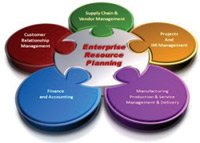
ERP solutions provide a mechanism for implementing systems, which require a high degree of integration between applications
In simplistic terms Enterprise Resource Planning (ERP) can be defined as a multi-module application software that integrates activities across functional departments, from product planning, parts purchasing, inventory control, product distribution, to order tracking. ERP software may include application modules for the finance, accounting and human resources aspects of a business.
Historically, companies created ‘islands of automation’ of various systems that operated or managed various divergent business processes. Desperate attempts are made to technically and functionally integrate these systems. Quite a few times they were loosely interfaced and on a few occasions they were tightly interfaced providing better service. To integrate all these systems better, ERP comes handy.

ERP has a certain set of characteristics which tilt the scale in favour of the system. Seamless integration of all information flowing through a company—financial/accounting, human resource, supply chain information and customer information is very crucial. Generally, enterprise systems are not developed in-house.
Organisations that purchase enterprise systems enter into long-term relationship with vendors and are not in a position to disassociate with the vendors providing the ERP and maintenance. These organisations have no control over their own destiny. Only the software is to be integrated and not the computing platform on which it runs. Most companies have great difficulty integrating their enterprise software with a package of hardware/software, database management system software and telecommunications suited to their specific needs.

Enterprise systems are changing rapidly, both architecturally and functionally. Architecturally, there are changes in mainframe, client/server, web-enabled, object-oriented, among others. Functionally, it pertains to front office, supply chain, data warehousing, specialised vertical industry solutions.
An important question that arises is why implement an ERP system? This is done to support business goals i.e. company being integrated, online, secure and having self service processes for business and eliminate costly mainframe/fragmented technologies. Improved integration of systems and processes leads to lower cost which helps maximise profits. There is no enjoying of the fact that such systems empower employees and enable partners, customers and suppliers into a better workable system, which is more effective, productive and at the end of it more profit generating. The objective is to obtain the right mix of people, processes and technology. People broadly mean they should be a part of project structure and should be appropriately aligned to the processes.
The process means the detailed outlining of an implementation process and adapting the process of the company to that of the ERP. Technology as a part of implementation means the appropriate hardware and software and finally the creation of integrated systems. The process implementation broadly deals with design, build, transition and production. First and foremost, discussions have to be held with various functional personnel to establish the actual number of systems operating at client side, what are they used for, why and how often. Next is the creation of a project scoping document outlining the current situation, proposed solution and budgeted time.
ERP today is a final hallmark of software creation. It can be safely concluded that ERP solutions provide a mechanism for implementing systems, which require a high degree of integration between applications and there is always a requirement of the Business Case or Value Proposition for the implementation to be outlined with clarity. In short, to successfully implement an ERP solution, a proper mix of people, process and technology should be maintaned.
Be a part of Elets Collaborative Initiatives. Join Us for Upcoming Events and explore business opportunities. Like us on Facebook , connect with us on LinkedIn and follow us on Twitter, Instagram.











